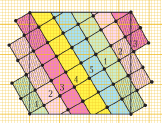It is well known (e.g. Vogel, "A better way to construct the sunflower head", 1979) that the pattern of florets on a sunflower head can be recreated by drawing points at polar co-ordinates $(\sqrt k, 2\pi k\phi)$, as $k$ ranges over integer or half-integer values $\ge0$; here $\phi=\frac{\sqrt5-1}{2}$ is the golden angle, and the radius of $\sqrt k$ ensures that the first $n$ points lie within a disc of area proportional to $n$.
It is also well known that on a unit sphere, a cap of height $h$ has area $2\pi h$. So an analogous pattern of points on a sphere could be chosen with cylindrical polar co-ordinates $(\sqrt{1-h^2},2\pi k\phi,h)$, with $h=\frac{2k}{n}-1$, as $k$ ranges over integer or half-integer values $\in [0,n]$. (Sorry if the notation or exposition are uglier than they might be.)
These point distributions, and the corresponding ("pinecone-like") polyhedra obtained by taking them as tangency points for faces, seem to me such an obvious candidate for study - both for theoretical interest and applications - that others must have considered them, but so far I've had difficulty finding appropriate search terms. Does anyone know what's been published (or informally noted) on this subject?
For anyone who might be unfamiliar, here's a picture of the planar distribution, from Wikipedia:


